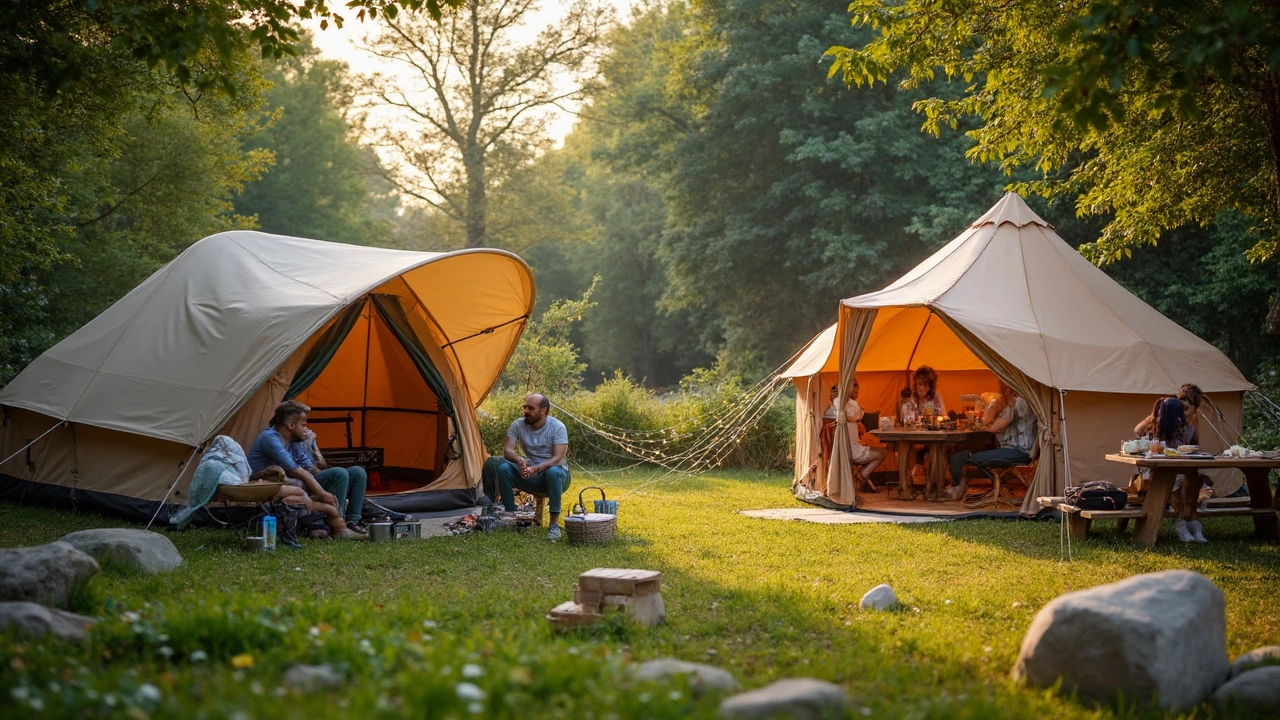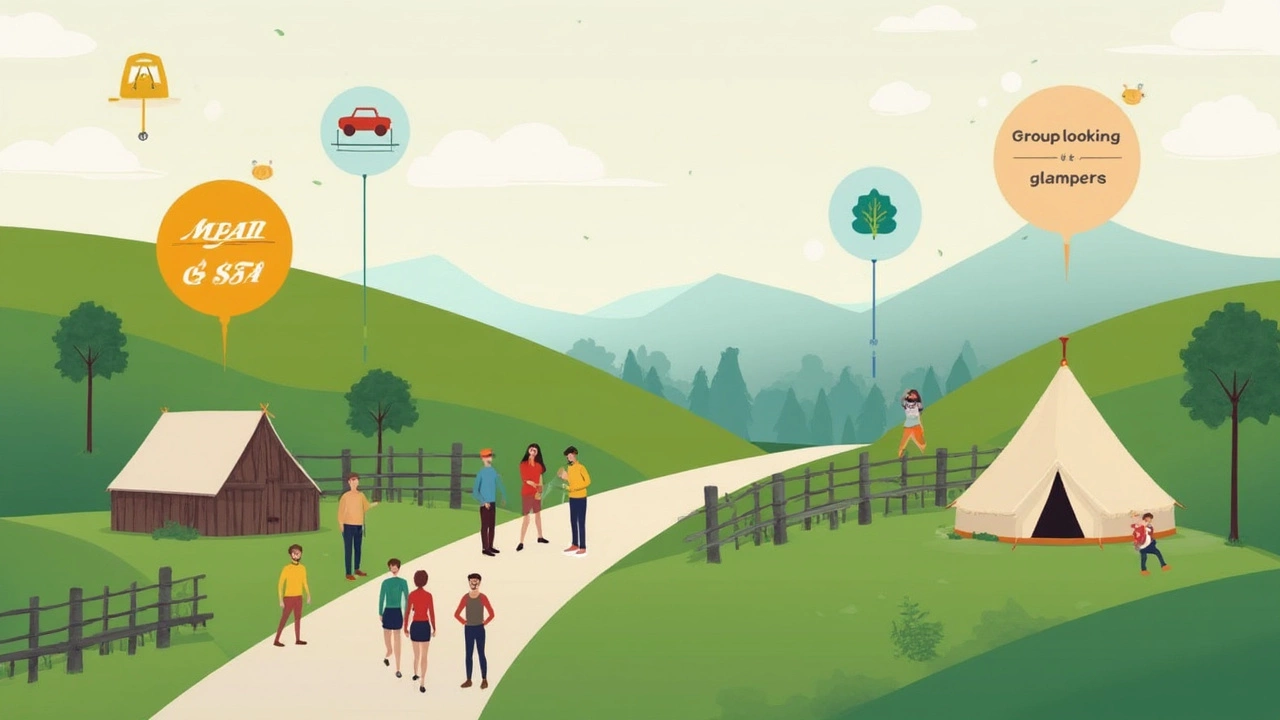Is Glamping More Expensive Than Camping? Real Costs, Tips & Comparisons for 2025
 Jun, 27 2025
Jun, 27 2025
Sticker shock. That’s what a lot of people feel after browsing glamping sites. Queen beds in canvas tents, private hot tubs under the stars, cozy wood stoves, room service… It sounds dreamy, right? But nobody talks about the invoice. Scroll a little and you’ll spot nightly rates that could rival a city hotel. How did sleeping outdoors turn into this high-end affair—and is glamping really more expensive than classic camping?
Breaking Down the True Cost: Camping vs. Glamping
Let’s unpack it honestly—no frills, no justifying. Straight up, glamping usually costs more than regular camping. The obvious reason? You’re paying for comfort and convenience. A tent you don’t pitch, beds you don’t air up, gourmet food you don’t grill. I remember booking my first glamping trip for our anniversary (Alistair couldn’t stop laughing when he realized there was a wine cellar in the yurt), and my phone buzzed with a payment confirmation that made me blink twice.
To make the difference clear, look at this cost breakdown comparing a three-night camping trip vs. a glamping getaway for two adults in 2025:
| Expense | Traditional Camping | Glamping |
|---|---|---|
| Accommodation (3 nights) | $90 (avg. $30/night for tent site) | $750 (avg. $250/night for glamping tent or cabin) |
| Food | $60 (groceries + snacks) | $160 (on-site dining, local food box) |
| Gear Rental/Purchase | $200 (if new tent, sleeping bags are bought) | $0 (included) |
| Extras (wood, parking, activities) | $55 | $120 (guided experiences, spa, etc.) |
| Total | $405 (first trip, gear included) | $1,030 |
So why the big difference? Glamping is like booking an outdoor Airbnb. The owner sets up the tent, stocks plush linens, keeps an espresso machine humming, and probably adds WiFi. And let’s be real: that personal hot tub isn’t running on promises alone. Compare this to traditional camping, where you haul the tent, shop for food, and cook over a smoky fire while shooing away Mistral—who, in my case, adores tangling herself in the guy lines. If you’re someone who buys gear just once, classic camping gets way cheaper over time.
Here’s the kicker: glamping costs swing wildly by location, season, and how luxury the set-up is. Expect to pay $120 to $500 per night in the US for glamping, according to a 2025 study by the American Glamping Association. Meanwhile, tent camping rates in state parks average just $25 to $40 per night.
Why Glamping Has Grown (And What You Get for the Splurge)
Glamping isn’t just tent camping with thicker mattresses. The whole vibe is tailored for folks who want Instagrammable nature without hauling their entire garage. You get private decks, bathrooms (sometimes with stone showers), chef-made meals, and beds with actual frames—no mystery back twinges. Think safari-style grandeur in the woods, minus the mosquitos pestering you through a ripped flysheet.
This luxury is why glamping is booming, even though it costs more. According to 2024 data from KOA’s annual North American Camping Report, 31% of new campers in the US chose glamping for their first experience. Glamping even topped traditional camping in revenue growth last year. Why? It’s popular among couples wanting a romantic escape (the candle-lit tubs!) and families whose kids won’t sleep on the ground anymore.
Don’t just think canvas tents and yurts. In Utah, you can glamp in old train cabooses; in Scotland, there are glamping treehouses with spiral slides; in Costa Rica, you’ll find domes in the cloud forest with velvet chairs buried in books. The focus isn’t just comfort, but curated experiences. Many sites offer stargazing with telescopes, on-site yoga, farm-to-table feasts, and wildlife tours. It’s easy to see the appeal if you want more than just “grab a pack and go.” It’s also pretty unbeatable if you don't want to argue over who forgot the can opener…again. (Alistair, I’m looking at you.)
But here’s the reality: glamping sites may have minimum stays—two nights, sometimes three on weekends. If you can grab a last-minute date or travel mid-week, you might snag discounts of 20% or more. Loyalty programs are popping up at bigger chains, offering perks for repeat guests. Check for package deals that bundle meals and guided activities; they can chip away at that four-digit total. And don't underestimate booking in the shoulder season—sites will drop prices quietly just after the summer crush.

Hidden Costs to Consider: What Doesn’t Show Up on the Website
No one likes surprises—especially not on a trip. Yet, glamping sites and campgrounds can both tack on sneaky fees, so watch those fine-print details. Glamping venues will sometimes charge “resort fees” for amenities like breakfast baskets, firewood, or even WiFi. You might also encounter cleaning fees (common in cabins and treehouses) of $30 to $90 per stay. Taxes can scramble the total—some localities add as much as 15% for short vacation rentals.
Traditional campgrounds aren’t free from hidden traps, either. Think $10 per car to park at state parks, $7 for a bundle of firewood (and you’ll need at least one per night if you’re anything like me), and reservation fees that run up to $10 a booking. Shower tokens? That’s a thing at some public grounds—expect quarters. If you’re tent camping, you’ll probably want to invest in things like solar lanterns or insulated pads, which add to your first-outing costs.
Something easy to forget is transportation. Many glamping spots are out in the wilds—a full gas tank (or two) might be needed to reach that secluded site. Some even require 4WD or charge for private shuttles. If you’re camping, you can usually stay closer to home or pile into a carpool.
Here are a few sneaky fees and extras to keep on your radar for both kinds of trips:
- Pet fees: Glamping sites often charge daily rates for pets, while campgrounds may allow them free or for a small one-time fee. I paid $30/night for Mistral once—a pricy nap for a cat who preferred sleeping in her carrier.
- Linens and towels: If you forget these at a glamp site, expect a rental fee.
- Activity add-ons: Horseback tours, yoga, guided hikes can add $20 to $150 per outing at glamping properties.
- Early check-in/late check-out: Sometimes these are charged at hourly rates.
- Cleaning deposits: If you’re too messy, part of your deposit might disappear.
One last tip: most glamping sites offer price match requests these days. If you spot a similar listing—say, a canvas bell tent with glowy lanterns and river access—try asking for a match. The worst they can do is say no, and you might just pocket some extra cash for that on-site spa treatment.
How to Save Money While Enjoying the Best of Both Worlds
You don’t have to pick one extreme or the other. There’s a sweet spot in between roaring campfires and high-thread-count sheets, and it doesn’t have to drain your wallet. If you crave some glamping perks, consider outfitting your basic camping setup with a few luxe upgrades. Bring cozy pillows and a thick sleeping pad. Battery-powered fairy lights are cheap, but add so much joy at night. Portable espresso makers? Game-changer—trust me, brewing real coffee in the woods is happiness. Alistair once rigged up a hammock with solar twinkle lights, and Mistral immediately claimed it as her throne.
For city folks or international travelers, renting gear is a game saver. Many state parks and outdoor stores now rent full kits—tents, pads, even solar lanterns and foldable camp kitchens. This keeps your upfront costs low, and you still get the satisfaction of sleeping under your own tarp. Don’t sleep on shoulder season or weekday bookings, either—glamping and camping are both quieter and cheaper outside summer Saturdays, plus you get more privacy (and less background noise at night).
If you have a big group, split the bill on fancier glamping options. Most sites accommodate up to four or six, making the per-head price much less shocking. Glamping pods, for instance, often run $200 a night but sleep four—cheaper than booking two hotel rooms. Some glamping farms offer communal kitchens where you can cook your own meals, skipping pricey on-site dining.
For traditional tent campers, invest once in good gear—especially quality sleeping pads and a sturdy, rainproof tent. It pays off after just a trip or two and sells easier second-hand. If you love that glamping style, there’s a growing market for stylish camp décor, from patterned rugs to insulated wine tumblers. A few YouTube tutorials later, and you can create your own “glampcamp” for a fraction of the Airbnb price.
Whatever you choose, be honest about your comfort needs. I once tried to tough it out on a budget foam mat and woke up creaky for days. If glamping lets you savor the outdoors in style, even if it costs more, that’s part of the adventure—just double-check the bill before you jump in. Nature doesn’t care how plush your bed is, after all—but you definitely will by morning.